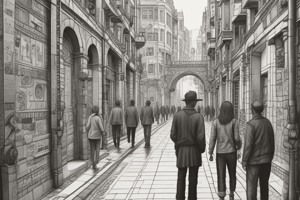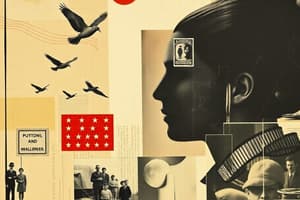Podcast
Questions and Answers
How does secondary socialization primarily differ from primary socialization?
How does secondary socialization primarily differ from primary socialization?
- It occurs within the family unit, shaping initial values.
- It solely involves learning about cultural traditions and customs.
- It focuses on teaching fundamental language skills.
- It takes place in institutions like schools and workplaces, reinforcing broader societal norms. (correct)
Which sociological perspective would most likely view shared values as integral to creating social stability?
Which sociological perspective would most likely view shared values as integral to creating social stability?
- Ethnomethodology
- Functionalism (correct)
- Conflict theory
- Symbolic interactionism
Which concept from symbolic interactionism suggests that our self-concept is significantly influenced by how we believe others perceive us?
Which concept from symbolic interactionism suggests that our self-concept is significantly influenced by how we believe others perceive us?
- The 'I'
- The looking-glass self (correct)
- Dramaturgical approach
- The 'me'
According to Goffman's dramaturgical approach, how do individuals navigate social interactions?
According to Goffman's dramaturgical approach, how do individuals navigate social interactions?
According to Blumer's principles of symbolic interactionism, from where do meanings primarily arise?
According to Blumer's principles of symbolic interactionism, from where do meanings primarily arise?
How do feminists view stereotypes?
How do feminists view stereotypes?
How would Goffman's dramaturgical approach explain a student behaving differently in a classroom compared to a party?
How would Goffman's dramaturgical approach explain a student behaving differently in a classroom compared to a party?
Which concept aligns with Weber's analysis of social stratification?
Which concept aligns with Weber's analysis of social stratification?
If a society emphasizes traditions and rituals to create social cohesion, which element of social construction is most evident?
If a society emphasizes traditions and rituals to create social cohesion, which element of social construction is most evident?
If a society values 'honesty,' which of the following would be an example of a norm that reflects this value?
If a society values 'honesty,' which of the following would be an example of a norm that reflects this value?
Which statement summarizes the social constructionist perspective on culture?
Which statement summarizes the social constructionist perspective on culture?
Which of Mead's concepts represents the socialized self that understands and considers societal expectations?
Which of Mead's concepts represents the socialized self that understands and considers societal expectations?
How does symbolic interactionism view the nature of identity?
How does symbolic interactionism view the nature of identity?
How does Mead's symbolic interactionism contribute to the nature-nurture debate?
How does Mead's symbolic interactionism contribute to the nature-nurture debate?
A person born into royalty has their social standing determined by __________ status, while a doctor earns their position in society through __________ status.
A person born into royalty has their social standing determined by __________ status, while a doctor earns their position in society through __________ status.
Flashcards
Culture
Culture
Shared beliefs, practices, and objects shaping a society's way of life.
Norms
Norms
Expected behaviors within a society; can be formal (laws) or informal (customs).
Values
Values
Deeply held societal beliefs about what is right and wrong.
Customs
Customs
Signup and view all the flashcards
Roles
Roles
Signup and view all the flashcards
Status (Achieved/Ascribed)
Status (Achieved/Ascribed)
Signup and view all the flashcards
Stereotypes
Stereotypes
Signup and view all the flashcards
Nature vs. Nurture
Nature vs. Nurture
Signup and view all the flashcards
Socialization
Socialization
Signup and view all the flashcards
Symbolic Interactionism
Symbolic Interactionism
Signup and view all the flashcards
The "self" (Mead)
The "self" (Mead)
Signup and view all the flashcards
Looking-glass self
Looking-glass self
Signup and view all the flashcards
Dramaturgical Approach
Dramaturgical Approach
Signup and view all the flashcards
Study Notes
- Society is a product of social construction.
Culture
- Culture encompasses the shared beliefs, practices, and material objects that shape a society's way of life.
- Durkheim emphasized culture's role in creating social cohesion.
- Weber highlighted the impact of ideas on shaping economic and social structures.
Norms
- Norms are the expected behaviors within a society.
- Norms can be formal (laws) or informal (customs).
- Parsons considered norms essential for maintaining social order.
Values
- Values are deeply held beliefs about what is right and wrong in a society.
- Functionalists believe shared values create social stability.
- Marxists view shared values as a reflection of ruling-class interests.
Customs
- Customs are long-established social practices, such as traditions and rituals, which reinforce social cohesion.
Roles
- Roles are the behaviors expected from individuals based on their social position.
- Goffman's dramaturgical approach explains how people "perform" roles in different social settings.
Status (Achieved/Ascribed)
- Status refers to a person's social standing.
- Status can be ascribed (given at birth, e.g., royalty) or achieved (earned through effort, e.g., a career).
- Weber distinguished between status and class in social stratification.
Stereotypes
- Stereotypes are oversimplified generalizations about groups, often reinforcing social inequalities.
- Feminists argue that gender stereotypes maintain patriarchal structures.
The Social Construction of Our Identity: The Nature-Nurture Debate
- Centers on whether human behavior is primarily shaped by biological factors (nature) or social influences (nurture).
- Sociobiologists like Wilson argue that genetics influence behavior.
- Social constructionists emphasize the role of socialization.
- Mead's symbolic interactionism suggests that identity is developed through social interactions, which reinforces the importance of nurture.
- Twin studies indicate that both genetic and environmental factors contribute to human development.
The Relativity of Culture
- Cultural norms and values vary across societies and time periods, demonstrating that they are socially constructed rather than universal.
- Margaret Mead's research on Samoan adolescence challenged Western assumptions about gender roles.
Socialization
- Socialization is the process through which individuals learn cultural norms and values.
- Primary socialization occurs within the family.
- Secondary socialization happens in institutions like schools and workplaces.
- Durkheim stressed socialization's role in social integration.
Norms and Values
- Norms are the specific rules governing behavior.
- Values are broader principles that underpin norms.
- The value of respect manifests in norms such as addressing elders politely
Symbolic Interactionalism
- It is a micro-level sociological perspective.
- It focuses on how individuals create meaning through social interactions.
- Theorists like Mead and Blumer developed it.
- People act based on the meanings they ascribe to objects, events, and other people.
- Meanings are shaped through communication and socialization.
- Mead's concept of the "self" explains how identity is formed through interactions.
- Identity is distinguished between the "I" (the spontaneous, individual self) and the "me" (the socialized self that considers societal expectations).
- Blumer expanded on Mead's work, outlining three key principles: people act based on meanings, meanings arise from social interactions, and meanings are modified through interpretation.
- Cooley's looking-glass self suggests that individuals develop their self-concept by imagining how others perceive them.
- Goffman's dramaturgical approach compares social life to a theatrical performance, where individuals present different "selves" depending on the social setting.
- Symbolic interactionism highlights the fluid, negotiated nature of identity and challenges deterministic views of human behavior.
Studying That Suits You
Use AI to generate personalized quizzes and flashcards to suit your learning preferences.




